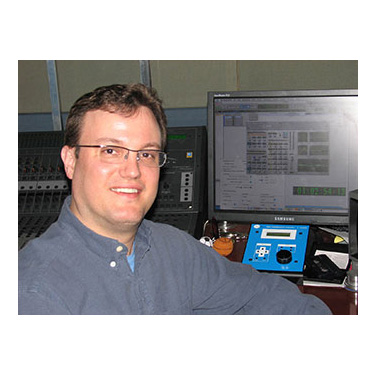|
 Senior mixer/designer at Washington D.C.-based Henninger Media Services uses Metric Halo's ChannelStrip as the cornerstone for his post-production work station. Senior mixer/designer at Washington D.C.-based Henninger Media Services uses Metric Halo's ChannelStrip as the cornerstone for his post-production work station.
WASHINGTON, D.C.: Time is of the essence in audio post-production, where a busy studio might have several completely different projects pass through in a single day. For Brad McIlvaine, senior mixer/designer at the Washington, D.C.-based audio design and mix division of Henninger Media Services, Metric Halo's versatile ChannelStrip plug-in is the cornerstone of a workflow that guarantees prompt delivery of the highest quality audio to his clients, whatever the project.
"ChannelStrip is THE go-to plug in my collection," says McIlvaine, who reports that he typically starts a project with ChannelStrip, which incorporates EQ, compressor and gate functions, assigned to every channel. "In post-production, EQ is crucial, while compression needs to be delicate at times and hard at others. ChannelStrip is the one plug-in that I don't feel I need to change depending on what sound source I'm working with."
ChannelStrip's intuitive graphic interface makes it a breeze to quickly add exactly the processing required wherever he needs it, continues McIlvaine. "The thing that makes it so fast for me is the graphic display. I do have a control surface and I can map ChannelStrip out to the knobs. But I never go to the knobs, even though it's a six-band EQ. I just grab it on the graphic and make it happen."
He elaborates, "I simply open ChannelStrip and then I can just grab the EQ point or compressor level. Once I grab what I'm trying to adjust I don't even need to look at the display. I simply move my mouse and let my ears tune it in. The feedback from the visuals is just tremendous. It's very intuitive. The interface is so fluid that I can easily get things dialed-in and set up in a flash. It's super easy."
While it is a simple matter to grab and adjust an EQ or compressor curve, a gate function typically requires values to be entered, he notes. But with ChannelStrip, even that operation is fast. "Plus," he says, "a lot of gates are very difficult to use, at least as far as getting something that has a broad working base, something that you're not going to have to fiddle with four times during a sound bite. The ChannelStrip gate is wonderfully functional."
In fact, operating ChannelStrip is so fast that McIlvaine has found little need to save any settings templates. "If I need to put a subtle EQ on a music track I find it's just faster to start off flat than to pull something up and tailor it. I know what I'm starting with, and I can dial it in exactly how I want it - no muss, no fuss."
The exception, he says, is "when I'm working on a show. Then I'll save settings. I have folders in my settings preferences, so I can go to the last show I did and see the different settings for each of the on-camera talent. Or, if I'm trying to roll a voice off, I'll sometimes reference back to the numbers for a male VO."
Henninger Media Services offers clients a complete video and audio post-production solution that includes graphic design and DVD authoring. Historically, says McIlvaine, he has been doing a lot of re-versioning into surround sound. "We're really into the surround side now for television. I have hardly left surround mode, except for one five-show series."
But multi-channel audio can stretch the resources of the audio system, he notes, which is where ChannelStrip has proved to be a real boon. "When you work in stereo, you think, my HD3 system is huge, I have power for days. But you open a surround session and all of a sudden your first card is dedicated to the surround mixer DSP and your plug-ins have to fit on everything else. So having a very DSP-sensible EQ, compressor and gate that also
sounds fabulous is great." |